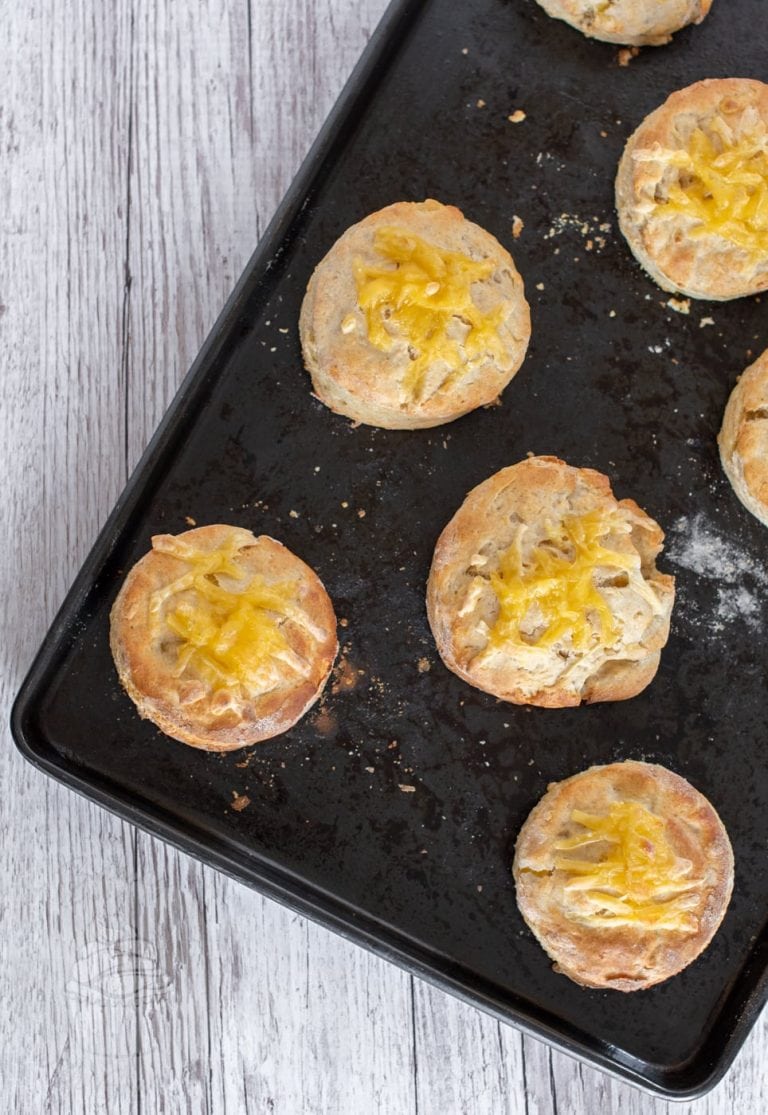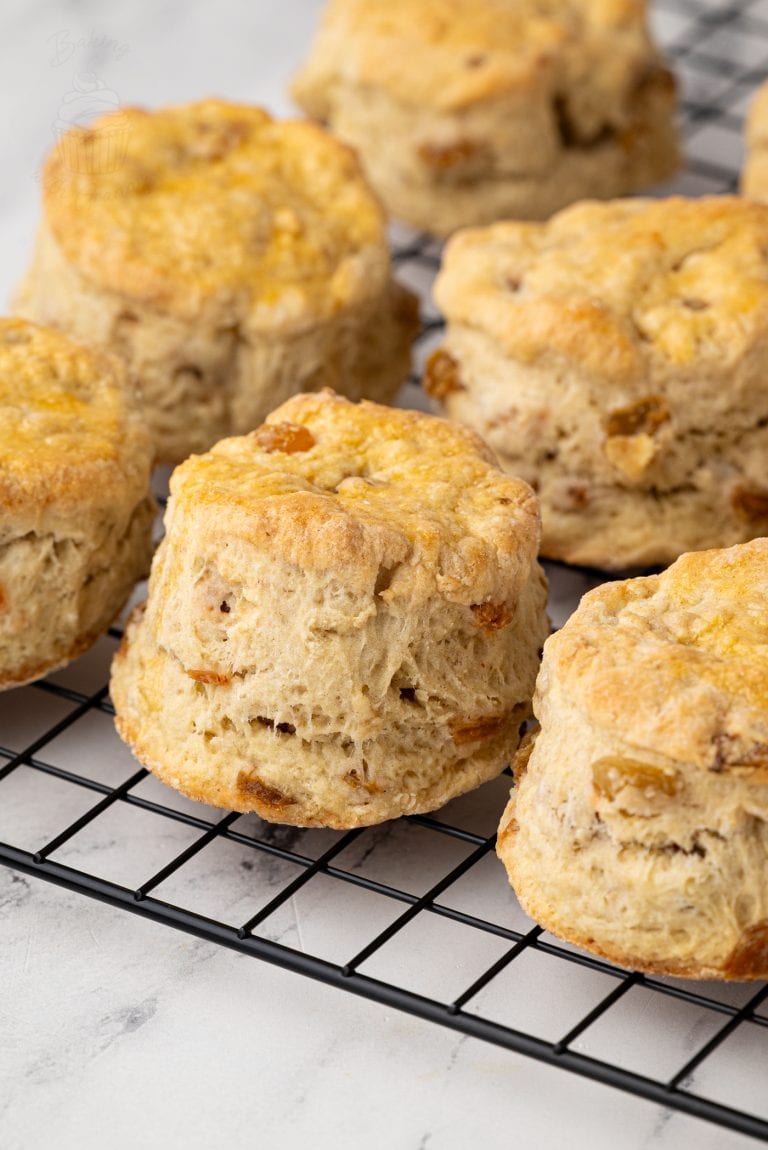Rhubarb Scones
Sweet, tart, and beautifully soft, these Rhubarb Scones are a spring-summer twist on the classic British scone. They’re perfect with a dollop of strawberry jam and enjoyed warm from the oven.
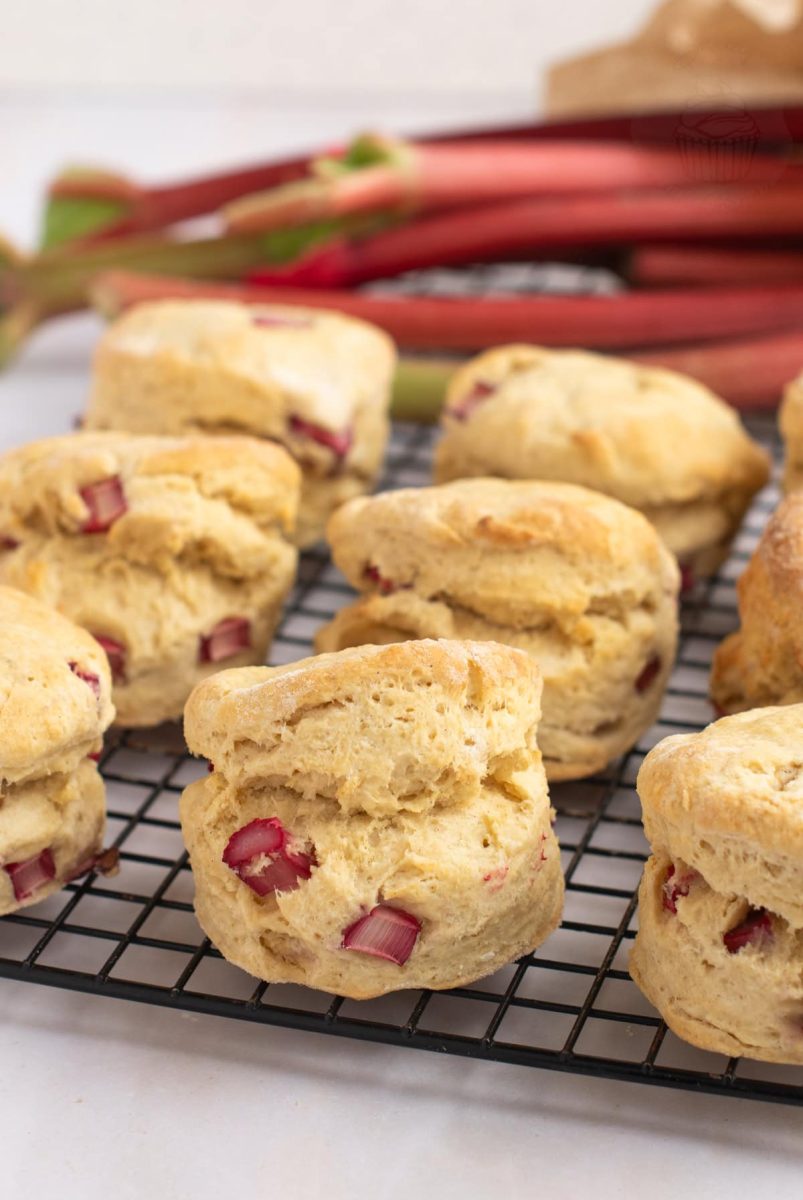
When I think of rhubarb, I think of Papa’s garden when I was just a wee girl.
Rhubarb was always one of those vegetables that he could grow, without really putting in much effort. So much so that it would take over an entire corner of the garden, and we’d then spend all spring-summer chasing our pet rabbit away from it!
Like many gardens and homesteads, we end up with a glut of rhubarb, year in, year out. Rhubarb Crumble is traditionally the favourite way to use up all those fresh stalks of homegrown rhubarb, but it’s always fun to experiment with other summer recipes, too.
I’ve already got a recipe for Cherry Scones and Blueberry Scones, so why not a recipe for Rhubarb Scones, too?!
Aiming for the classic “rhubarb and custard” flavour combo, I have added a little vanilla to the dough, alongside the chopped fresh rhubarb. Alternatively, you could lean into the rhubarb and ginger flavour palette with some pieces of crystallised ginger. Or simply keep it fruity with some summery orange zest.
Whatever your preference, I always recommend serving with a good dollop of strawberry jam, giving you the unbeatable strawberry-rhubarb combo.
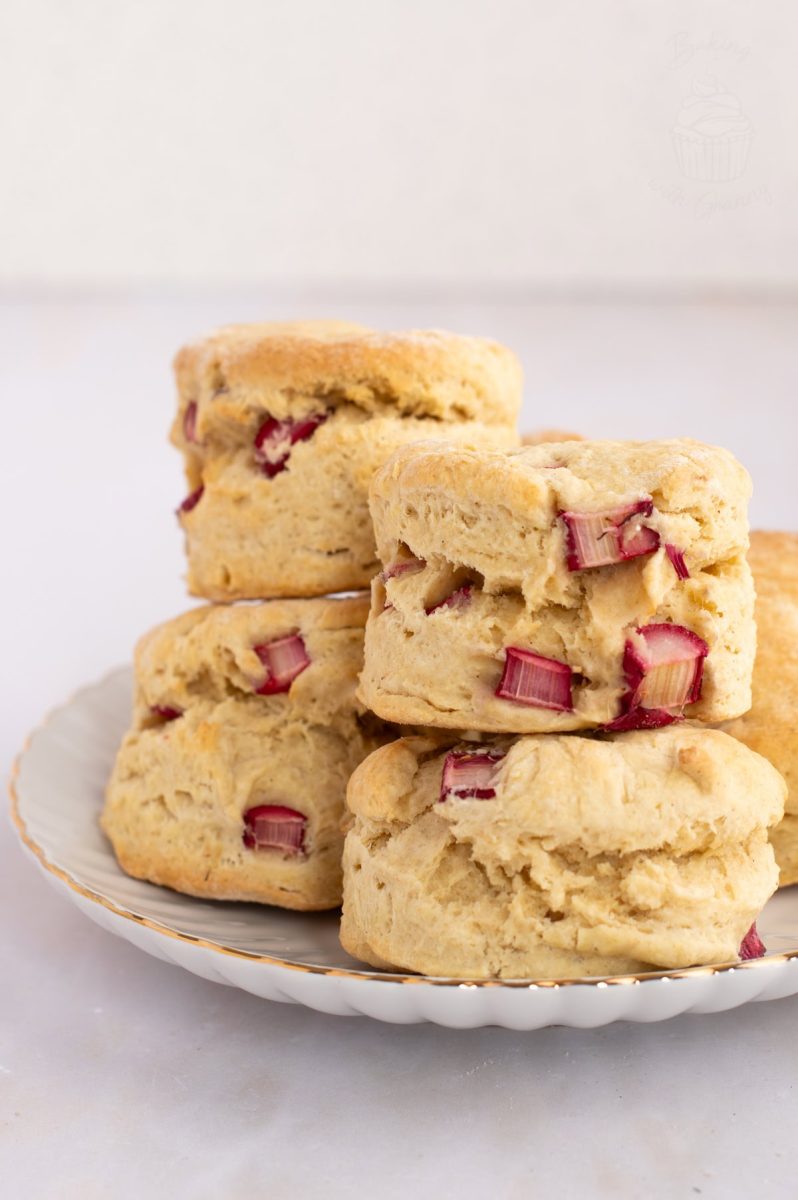
Top Tips for Scone Success:
• Cold Ingredients, Hot Oven: For great scones, you want cold ingredients and a hot oven. Use margarine/butter that is a little cold, and ensure you fully preheat your oven.
• Sift the Flour: Try to get as much air into your dough by sifting the dry ingredients from a bit of height and raising your fingers as you rub in the butter.
• Be Gentle with the Dough: Scones require a soft touch, so don’t be too rough with your mixing and kneading.
• Put Down the Rolling Pin! Simply stretch out your dough with your hands. And always leave it a little thicker than you think you should.
• Don’t Twist the Cutter: When you cut your scones from the dough, DO NOT twist your cookie cutter. This will twist the edges of the dough and prevent them from rising as well.
• Give Them a Rest: Always leave your scones to rest before baking. This lets the gluten in the flour rest & calm down a little. 10 minutes is ideal, but even better if you can do longer. I’ll usually do my dishes during this time.
• Glaze Before Baking: A beaten egg gives the best colour to scones when brushed on top, but milk is my personal preference. Just be careful that you don’t let it run down the sides of your scones, or it could affect the rise.

More Scone Recipes You’ll Love:
• Fool-proof Plain Scones
• Fruity Blueberry Scones
• Scottish Treacle Scones
• Savoury Tattie Scones
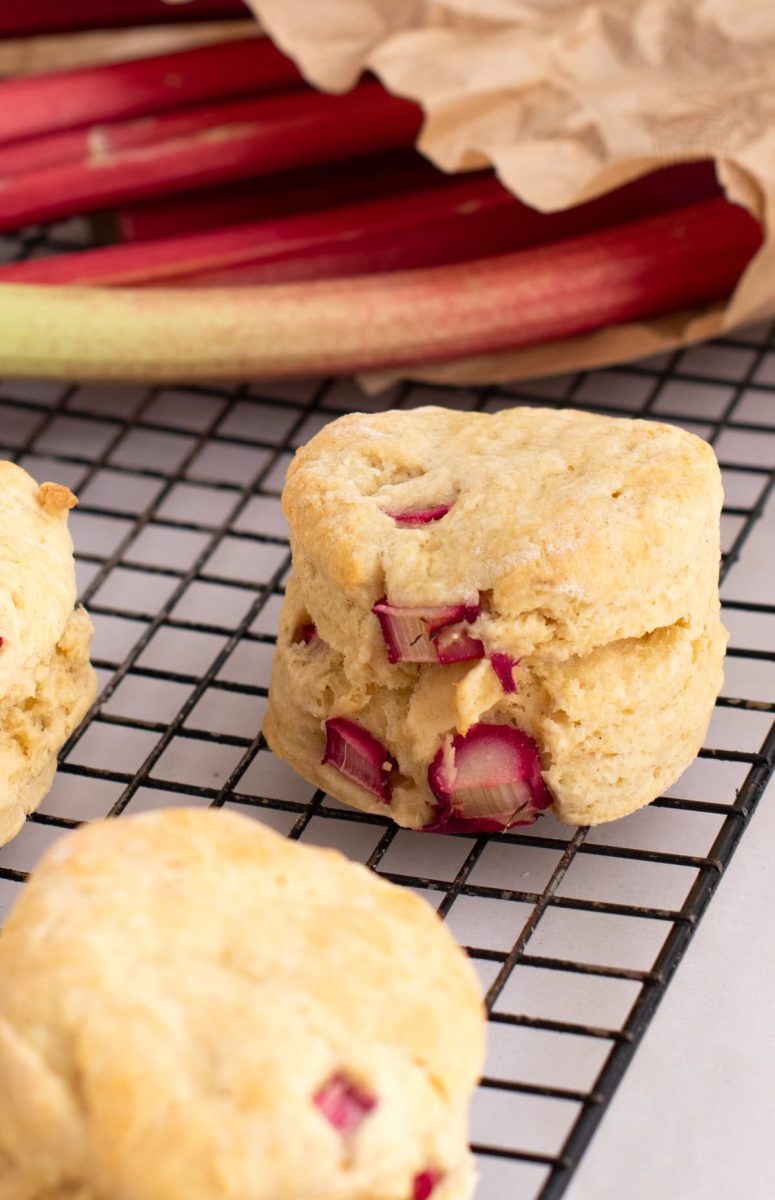
Save this recipe!
Want to save this recipe for later? Pop your email below and come back to it when you’re ready to bake.

Rhubarb Scones
EQUIPMENT
INGREDIENTS
- 450 g Self-raising Flour
- Pinch of Salt
- 2 tsp Baking Powder
- 50 g Butter or Margarine
- 50 g Caster Sugar (Superfine Sugar)
- 200 ml Milk
- 100 ml Plain Yoghurt (dairy, soya, coconut…)
- ½ tsp Vanilla Extract (optional)
- 100 g Rhubarb (fresh, chopped)
INSTRUCTIONS
- Pre-heat your oven to 220°c (200°c for fan-assisted oven, Gas Mark 7 or 425°F). Grease two baking sheets with a little butter and set aside.
- Sift the flour, salt and baking powder into a large bowl, holding the sift up to allow some air into them. Gently stir in the sugar.
- Using the tips of your fingers, rub in the margarine/butter to the dry ingredients, again lifting as you do to allow air in. Continue until you have a sandy consistency.
- Create a well in the middle. Whisk the milk, yoghurt and vanilla together before pouring into the well. Mix a little before adding the rhubarb Using your hands, gently bring the ingredients together to form a soft, slightly sticky dough.
- Turn out onto a floured work surface and gently knead together, before stretching the dough to about 2-3cm thickness.
- Using a cookie cutter of your choice, cut your scones out and place them onto your pre-greased baking sheets. The smaller your cutter the more scones you will get. Reform and stretch the dough as required to use all of the dough.
- Leave your scones to rest on the tray for about 10 minutes before brushing the tops with some extra milk.
- Bake in your pre-heated oven for 10 minutes. If you are making smaller scones, keep a close eye on them as you may need to reduce the baking time accordingly.
- Once cool enough to touch, transfer to a wire rack to cool completely or enjoy whilst still warm.
IMPORTANT NOTE:
All my recipes are developed using a digital scale and the metric system (grams and millilitres). Cup measurements are available as a conversion but these, unfortunately, won’t always be as accurate. For best results, I always recommend baking with a digital scale.
RECIPE NOTES:
- Please see my Tips for Success above for all my tips for achieving the perfect scones.
- Rhubarb Scones are best enjoyed the day they are baked, but they can be stored in an airtight container for a few days. You can also reheat them (in the microwave or toaster) to bring them back to life a little.
- Scones freeze very well. Pop them into a freezer bag and remove them one at a time, as required. Allow them to come to room temperature before serving. You can also reheat them (in the microwave or toaster) to bring them back to life a little.
- For tips on how to make your Rhubarb Scones vegan or free-from, see the Free-from & Vegan box below.
Yes! Fresh rhubarb gives the scones a lovely tart flavour and has a soft texture once baked, making this rhubarb scones recipe the perfect bake for using up a glut of garden rhubarb. Just be sure to wash and chop it into small pieces before adding to the dough.
Yes! You can absolutely use plain flour in place of self-raising flour in scones, but you will need to add the raising agents that you would usually find in self-raising flour.
The general rule of thumb is to add 2 teaspoons of baking powder for every 150g of plain flour.
So, in this recipe, you would use 5 teaspoons of baking powder as there is 450g of flour; not forgetting the additional 2 teaspoons of baking powder that the recipe calls for, too.
So in total, 7 teaspoons of baking powder when using plain flour.
In short, no. Scones do not need eggs. However, some recipes will add an egg to their scone mix
Adding an egg to scones can add a certain richness, as well as extra moisture. But for your everyday scone, it just isn’t necessary.
These scones are not at all dry, and they are plenty rich. By keeping to a traditional no-egg scone mix, you also make them much more affordable.
Of course! Scones freeze very well, in fact.
Pop them into a freezer bag and simply take a scone out at a time when you want to eat them. Ideally, you would leave them to defrost at room temperature, but you can defrost them in the microwave too.
Free-from & Vegan
Dairy-free: To make this a dairy-free scones recipe, simply use a dairy-free milk, yoghurt & margarine for a dairy-free scone.
Nut-free: There are no nuts used in this scone recipe but, as always, be sure to double check your individual ingredients allergens list.
Vegan: As there is no egg in this scone recipe, simply follow the dairy-free tips above to make these a vegan rhubarb scones recipe.
N.B. Any advice or suggestions to make recipes “free-from” or vegan are purely that – suggestions. Please be careful to double-check all ingredients individually, taking extra caution when serving to those with allergies & intolerances.
For more info on common food allergies, please see food.gov.uk | For more info on coeliac disease, please see coeliac.org.uk | For more info on a vegan diet, please see vegansociety.com



